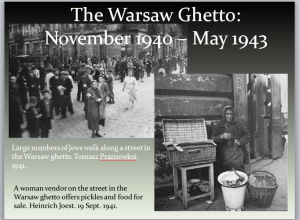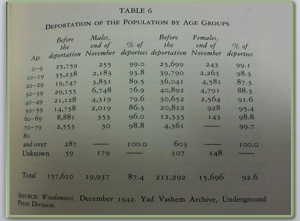I chose to create slides about Jewish resistance to the Nazis in Poland’s Warsaw ghetto. I prepared a more comprehensive presentation for another history class in which I’m writing a paper about the topic, and it was difficult to decide which three slides to include. I enjoy using Prezi, but I thought it would probably be easiest to use PowerPoint since we were only creating a mini-presentation. I prefer to keep my PowerPoint slides relatively simple, so the slides shown here contain only pictures and their captions (as provided by the Holocaust Museum).
Our discussion in class today got me interested in thinking about what other design choices I could have made; I think I could probably change my font to something that looks more like the typewriter-style font from the Vietnam War website we viewed, which has a certain military connotation and would reflect the creation of clandestine newspapers and the Oneg Shabbat Archives I discuss in the full version of my presentation. Because my actual presentation was being given to a class in a relatively large room, I made the captions bigger than I normally would so that they would be visible; otherwise, I definitely would prefer that they be smaller.
The Nazis invaded Poland on September 1, 1939. Within a few days, they had reached its capital, Warsaw, and they began a fierce bombardment campaign. With its conclusion and their entry into the city, the Germans were quick to enact a series of anti-Jewish policies; employment restrictions and confiscation of property were commonplace. Jews were routinely kidnapped to perform forced labor, and sporadic acts of violence were also committed against them. By November 1940, Jews had been forced to relocated to the city’s “Jewish quarter” following a typhus outbreak the previous year, during which the Nazis called the Jews “unclean” and set aside a special section of the city in which to consolidate them. The ghetto was overcrowded (30% of Warsaw’s population had been forced into 2.4% of the city) and unsanitary, and disease was rampant. Starvation was also prevalent, as Jews received a ration of 184 calories per day! These conditions forced Jews to resort to selling or trading any possessions they still had for food, or for participating in the illegal food-smuggling underground.
On July 22, 1942, German troops surrounded the ghetto. A proclamation was issued stating that a quota of Jews each day was to be “transported” or “relocated” to the East for work. In reality, these Jews were being sent to their deaths at Treblinka. About 254, 000 Jews, or 75% of the ghetto population, perished in this first wave of deportations. Young children and the elderly were almost completely annihilated. The second deportation occurred in January of 1943, and though many Jews were able to hide and some small skirmishes broke out between Nazis and members of underground Jewish political groups, between 5000 – 6500 Jews were taken to Treblinka.
The final deportation, or liquidation, of the Warsaw ghetto began the day before Passover–April 19, 1943. Though the Nazis attempted to catch the Jews off-guard, two underground resistance groups–the ZOB and ZZW–were ready for them. Supplied with some weapons smuggled from the “Aryan” side of the city and armed with homemade Molotov cocktails and bombs, the Jewish resistance fighters confronted the Nazis in the streets and from the rooftops. Jewish civilians resisted passively, as well–many of them went into hiding underground, where they had constructed bunkers with electricity and running water. The Nazis’ three-day liquidation program turned into a battle that raged for 28 days. The Jews were out-manned and out-gunned, however, and on May 16, 1943, the Jewish synagogue was bombed and then the rest of the city was razed. Most of the Jews who were unable to escape to the “Aryan” side during the chaos perished. Though a military victory for the Germans, the Warsaw Jews’ incredible bravery and refusal to submit to the Nazis served as inspiration for countless others repressed by the regime and the model for resistance in many other places.



